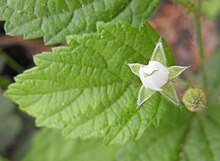Rubus leucodermis
| Rubus leucodermis | |
|---|---|

| |
| var. bernardinus | |
| Scientific classification | |
| Kingdom: | |
| (unranked): | |
| (unranked): | |
| (unranked): | |
| Order: | |
| Family: | |
| Genus: | |
| Subgenus: | |
| Species: | R. leucodermis
|
| Binomial name | |
| Rubus leucodermis | |
| Synonyms[1] | |
| |
Rubus leucodermis, also called whitebark raspberry, blackcap raspberry or blue raspberry,[2][3] is a species of Rubus native to western North America, from Alaska south as far as California, Arizona, New Mexico, and Chihuahua.[4][5][6][7][8]
Rubus leucodermis is closely related to the eastern black raspberry Rubus occidentalis. The name leucodermis means "white skin", referring to the white appearance of the stems because of a thick waxy coating on the surface.[7]
Rubus leucodermis is a deciduous shrub growing to 0.5–3 m tall, with prickly shoots. While the crown is perennial, the canes are biennial, growing vegetatively one year, flowering and fruiting the second, and then dying. As with other dark raspberries, the tips of the first-year canes (primocanes) often grow downward to the soil in the fall, and take root and form tip layers which become new plants. The leaves are pinnate, with five leaflets on leaves' strong-growing stems in their first year, and three leaflets on leaves on flowering branchlets with white and infrequently light purple flowers. The fruit is 1–1.2 cm diameter, red to reddish-purple at first, turning dark purple to nearly black when ripe.[9] The edible fruit[10] has high contents of anthocyanins and ellagic acid.[2][7]
It is a variable species, and forms natural hybrids with other species in subgenus Idaeobatus. Three varieties are recognized:[3]
- Rubus leucodermis var. leucodermis – Alaska to Chihuahua
- Rubus leucodermis var. bernardinus Jepson – southern California
- Rubus leucodermis var. trinitatis Berger – southern California
Gallery
-
Fruit
-
Leaves
-
Bush in Nevada
See also
- Blue raspberry flavor
- Rubus niveus and Rubus coreanus, related Asian species
References
- ^ Tropicos, Rubus leucodermis Douglas ex Torr. & A. Gray
- ^ a b "Jepson Flora Project: Rubus leucodermis". Jepson Herbaria, University of California at Berkeley. Retrieved 2012-08-27.
- ^ a b "NCRS: USDA Plants Profile: Rubus leucodermis". US Department of Agriculture. Retrieved 2012-08-27.
- ^ "Rubus leucodermis". Germplasm Resources Information Network. Agricultural Research Service, United States Department of Agriculture. Retrieved 2012-08-27.
- ^ "Biota of North America Program 2014 county distribution map".
- ^ Calflora taxon report, University of California, Rubus leucodermis Torrey & A. Gray, White Stemmed Raspberry, western raspberry, white bark raspberry
- ^ a b c Flora of North America Rubus leucodermis Douglas ex Torrey & A. Gray, 1840.
- ^ "SEINet – Arizona Chapter – Rubus leucodermis". swbiodiversity.org.
- ^ Pojar, Jim; Andy MacKinnon (2004). Plants Of The Pacific Northwest Coast: Washington, Oregon, British Columbia & Alaska. Lone Pine Publishing. p. 77. ISBN 978-1-55105-530-5.
- ^ Fagan, Damian (2019). Wildflowers of Oregon: A Field Guide to Over 400 Wildflowers, Trees, and Shrubs of the Coast, Cascades, and High Desert. Guilford, CT: FalconGuides. p. 88. ISBN 978-1-4930-3633-2. OCLC 1073035766.
External links
- Rubus
- Berries
- Flora of Alaska
- Flora of British Columbia
- Flora of California
- Flora of New Mexico
- Flora of Northwestern Mexico
- Flora of the Cascade Range
- Flora of the Northwestern United States
- Flora of the Sierra Nevada (U.S.)
- Flora of the Southwestern United States
- Garden plants of North America
- Natural history of the California Coast Ranges
- Natural history of the Transverse Ranges
- Plants described in 1840



